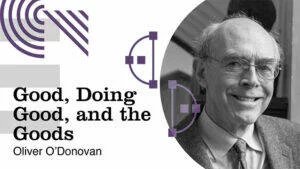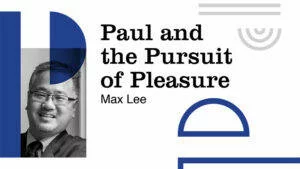 The Hebraic intellectual world on display in the Bible, unlike the rest of the ancient Near East, creates the epistemological condition for a logic of signs and wonders against chance.
The Hebraic intellectual world on display in the Bible, unlike the rest of the ancient Near East, creates the epistemological condition for a logic of signs and wonders against chance.
Thanks to my mathematician colleague Dr. Phillip Williams and my philosophy colleague Dr. Joshua Blander for help thinking through this topic. The following is very much a thought in progress. Conversely, in a Near Eastern conceptual world that understands every doorway, cat’s path, moonrise, etc., ad infinitum to be discrete nonverbal signals from the gods, the biblical signs and wonders make little sense unless they are weighed against the chance of another god’s actions or a law-like natural world in which something could have happened unrelatedly: by chance. This metaphysical conviction of law-like nature, which included God’s bending of creation, conditions the conceptual space to think about randomness as a form of “we don’t know how A is connected to B,” which allows for calculations of “what are the chances that A had something to do with B”?
Why are signs convincing and what rationality do they invoke within the biblical logic of miracles? For instance, why would a staff-turned-snake convince a rational person to act out a plan to cripple Egypt and redeem Israel?Why are signs convincing and what rationality do they invoke within the biblical logic of miracles? For instance, why would a staff-turned-snake convince a rational person to act out a plan to cripple Egypt and redeem Israel? How does a Hebrew know that the staff didn’t turn into a snake by chance or for some other purpose? That might seem laughable, but that was the exact quandary later posed when Moses performed the same wonder before the Pharaoh. When Egyptian magicians reproduced the first two wonders that were signs to Moses, they lost all signaling power when quickly reproduced in the court of Pharaoh.
Moses’s first two miracles didn’t actually “work,” but notice that the plaguing wonders that followed were accompanied with “so that you will know” clauses, almost a dozen of them. These plagues were meant to convince. Against the chance that the Egyptian gods were somehow involved with the plagues, these wonders signaled God’s powers and intentions.
Yet, it’s the final plague that clarifies the cause of death against the chance of “natural causes”—not that Egyptians would have ever construed death as “by chance.” No natural or divine cause within Egyptian theology tracks birth order and then kills the oldest. Killing the first-born requires both personal agency and causal force in the cosmos. Gods having causal powers would have been theological boiler plate to most folks in the ancient Near East, so no need to have that conversation. But this tracking and acting upon discrete classes of individuals—the firstborn—is novel.
Moses’s commands and explanations of the divine plagues did their work to convince Egyptians and Israelites alike of his authority entirely outside of the power structures of the empire or gods. Unlike the initial signs performed by Moses, the wonders that persisted to brutalize Egypt had no courtier’s counterpart and led even the Pharaoh and other Egyptians to recognize the unique authority of Moses and Yahweh (cf. Exod 9:20, 27–28; 12:32).
Again, how did such wonders serve as signs? Looking across several of these sign/wonder events, an unstated presumption of law-like operations appears to be contrasted with a rough and ready measurement of something happening “by chance.” In other words, a “by chance” metric arbitrates what counts as a sign/wonder and points to a personal agent who signals his intentions by both discourse and the strategic bending of creation. In the ancient Near East, with chance generally ruled out of the question, we would be left asking, “Which god did this?”
Moses later sets up the death of Korah and his men with this against-chance formula. In Numbers 16, Moses frames the situation with an if/then-you-shall-know formula:
If these men die as all men die, or if they are visited by the fate of all mankind, then Yahweh has not sent me. But if Yahweh creates something new, and the ground opens its mouth and swallows them up with all that belongs to them, and they go down alive into Sheol, then you shall know that these men have despised Yahweh. (Num 16:29–30)
The earth can split open. That may be rare or extraordinary, but it’s not an unknown wonder in a tectonic plate zone known as the “Holy Land.” This event moves from known seismic activity to a wonderIn other words, a “by chance” metric arbitrates what counts as a sign/wonder and points to a personal agent who signals his intentions by both discourse and the strategic bending of creation. that acts a sign only when put in the context of the historical rebellion and also measured against a background assumption of happening “by chance.”
Against-chance calculations are relativized to other theological explanations. What is the likelihood that Ba’al caused this to happen? These texts reveal the rationality expected by and normative for the biblical authors. Elijah’s challenge to the prophets of Ba’al focuses, not on if a god controlled the lightening and rains, but which name that god answered to: Ba’al or Yahweh (cf. 1 Kgs 18:24, 32, 36–39). Getting the correct name behind the action leads to proper worship of that god, which leads to rains and food, which then leads to survival, which then drives worship, and so on. Witnesses of wonders aren’t cold subjects encountering raw data, they have skin in the game.
While Scripture offers repeated glimpses at its conceptualization of randomness in the many passages about God’s sovereignty, the functional calculus of determining the source behind the bending of nature (i.e., a wonder) provides us a good-enough picture as to how epistemological randomness—the inability to discern a pattern—fits into the intellectual life presumed throughout Scripture.
Below, I consider meteorological signs/wonders. Specifically, on what basis does manna move from sign/wonder in Exodus to ordinary meteorology in Numbers and then back into the realm of sign/wonder in Joshua? In a similar way, how does a wet fleece and dry ground affirm or deny anything?
The Biblical Logic of Signs and Wonders Against Chance
Unlike their peers in the ancient Near East, Yahweh’s signs and wonders campaigns presume both law-like causation and a measurable probability of something happening against chance. Like most scientific experimentation today, epistemologically random expectations become the background to which an event is tested. Let us briefly consider Exodus’ manna and Gideon’s fleece as two forms of meteorological signs/wonders.In order to get to the point quickly, I will state some undefended biblical theological points that I’m relying upon in this section: (1) The natural universe is law-like: an ancient scientific metaphor that implies a person (i.e., king or regent) who causally regulates the cosmos; (2) nature was de-naturalized in Genesis 3, where the metaphysical orientation of the universe moved from beneficence to decay; (3) though still law-like in its regulation and design, all of creation is presently unnatural: corrupted, twisted, cancerous, warped, and whatever other metaphor does the job; (4) with the biblical authors, I would argue that causal relations exist between everything in the cosmos, more faint or forceful in power, and God is part of that causal matrix.
Manna
The manna episodes help to demonstrate that an extraordinary phenomenon—a so-called “miracle”—can both act as a sign and later become normalized to the point that it’s no longer a wonder. When manna first falls in Exodus 16, it creates perplexity—hence the name manna roughly translates: “what’s-it,” “For they did not know what it was” (Exod 16:15).
The story within which the manna falls indicates that this bread is indiscernible according to their background knowledge of meteorology in Egypt and the Sinai Peninsula: food doesn’t come from the heavens like this. Further, the manna acts as a sign because it is a wonder (Exod 16:32–35), it defies every known probability of meteorological food in their experience in Egypt. Even if there were a natural event of flakey food in the Sinai, the Sabbath regulation of manna created physically different manna on the sixth day of each week and none on the seventh day (Exod 16:20–28). Manna, for the Israelites, was a sign because it was a wonder in that specific context. Like all signs, it was accompanied by words of explanation and “then you all shall know” as a stated outcome (Exod 16:6, 12). What’s-it is given for the sake of coming to know.
Conversely, all the children born during the Sinai wandering must have seen manna differently. They never knew a world in which manna didn’t fall from the heavens—like Scottish children who rarely know of a day where water doesn’t fall from the sky. Manna was a natural meteorological phenomenon for children on the way to Cana’an.
Hence, the manna became normalized and lost its value as a sign, because it was no longer a wonder. Only by their parent’s explanation could they trustingly understand manna as a sign and wonder.
Yet, when those same children enter into Cana’an, the manna ceased “the day after they ate of the produce of the land” (Josh 5:12). The cessation of the manna has once again become a sign and a wonder for the next generation, something entirely normal ceases upon the completion of a Deuteronomic promise. For the first and last manna eaters, the wonder requires a rough “against chance” calculation in order for it to function as a sign. But what about normal events used as signs from God?
Gideon
Turning to Judges, Gideon famously tests Yahweh in Judges 6 to determine the authenticity of Yahweh’s intention to “save Israel by [Gideon’s] hand” (Judg 6:36). When the divine messenger of Yahweh greets Gideon with “Yahweh is with you,” Gideon’s skepticism questions the premise according to his own lived reality: Then why has all this [Midian oppression] happened to us and “where are all His wonderful deeds that our fathers recounted to us” (Judg 6: 13).
After being initially convinced that a messenger of God has visited him (Judg 6:22), Gideon then revisits God’s plan to save Israel with rightful skepticism. Gideon asks for another sign to confirm the ambitious plan to save Israel by his hand.
He proposes the following test with the result then “I shall know . . .”:
-
If wet fleece/dry ground
The first experiment was meant to justify Gideon’s trust in the plan. For reasons unknown to us, Gideon then pushes Yahweh for another sign in order to justify his trust in the first sign through a reversal of the sign.
Why reverse it? Maybe Gideon realized that the sign wasn’t necessarily a wonder. As anyone who has camped in a tent knows, wet fabric and dry ground in the morning is a known phenomenon. So Gideon asks God to dew it again, this time in reverse.
-
If dry fleece/wet ground, then (implied) “I shall know . . .”
Both of Gideon’s experiments contain the premise that Yahweh caused both instances to happen, but the second test confirms this premise—God caused this—by creating an implausibly reversed meteorological demonstration of the first sign. Notice that it’s only implausible when weighed against the background possibility of it happening by chance. The first sign could have been a meteorological fluke. The second sign, in particular, required actions upon a natural environment that could only be solved by a personal agent with power over meteorology. Just like the sixth-day manna that didn’t rot, by reversing the sign, the wonder is only as efficacious as it can be measured by its improbability.
In both of these examples of God testing persons and Israelites testing God, the construct requires an experimental design with determinable parameters that creates the conditions for check “against chance.” Or, in the language of signal detection theory, the sign/wonder functions as a “hit” distinguishable from “misses” and provides room for “correct rejections”—all of which must be properly interpreted against chance.
Conclusions
In the biblical logic of signs and wonders, a rough heuristic resembling a Bayesian probability—that this would not have happened by chance or by another divine being—gets resolved by God’s personally-communicated causal actions responding to human requests. Not so for Mesopotamians and much of Egypt, where events and attributes are all portentous from the gods. For them, there is no need for an against-chance calculation because all events and spaces are indirect messaging. In the Hebrew Bible, God speaks directly through his prophets and coordinates wonders against-chance in order for them to act as signals of his intentions and promises.
In this sense, extraordinary phenomena such as manna and ordinary phenomena such as a wet fleece and dry ground can both act as a sign and wonder when considered in a world where:
- God directly communicates,
- God is a cause of both law-like regularity and the bending of that nature, and
- epistemological randomness is rationally as good as we get.
For Moses with his staff, Israel with her manna, and Gideon with his fleece, a reasonable conviction that we cannot causally trace all phenomena is all that is needed in order to make proper calculus about wonders acting as signs. In their world, as it was for Enlightenment empiricists and a growing number of physicists today, that kind of calibrated against-chance calculus is as good as it gets. Anything beyond the epistemological sense of randomness creates more logical problems than it can resolve.







Nisam mogao vjerovati, sretan sam i ponovno sam financijski stabilan i zahvaljujem Bogu što ovakve kreditne tvrtke još uvijek postoje na ovim prijevarama posvuda, savjetujte svima koji trebaju posuditi kredit e-poštom ([email protected]) nikad ne uspijete i vaš će se život promijeniti kao i moj. Brzo kontaktirajte ([email protected]) danas i uzmite svoj zajam od njih. Obavezno kontaktirajte DAVIDSON ALBERT LOAN COMPANY za vaš kredit, jer sam uspješno dobio svoj kredit od ove tvrtke bez ikakvog stresa. Posjetite njihovu e-poštu. ([email protected]) com) nikada te neće iznevjeriti i tvoj život će se promijeniti kao i moj. Brzo kontaktirajte ([email protected]) danas i uzmite svoj zajam od njih. Obavezno kontaktirajte DAVIDSON ALBERT LOAN COMPANY za vaš kredit, jer sam uspješno dobio svoj kredit od ove tvrtke bez ikakvog stresa. Posjetite njihovu e-poštu. ([email protected]) com) nikada te neće iznevjeriti i tvoj život će se promijeniti kao i moj. Brzo kontaktirajte ([email protected]) danas i uzmite svoj zajam od njih. Obavezno kontaktirajte DAVIDSON ALBERT LOAN COMPANY za vaš kredit, jer sam uspješno dobio svoj kredit od ove tvrtke bez ikakvog stresa. Posjetite njihovu e-poštu. ([email protected])